Resources
Trends
The experts consulted in the horizon scanning exercise prioritised a larger count of environmental trends, reflecting the focus of wood cascading solutions as circular economy initiatives that are fundamentally driven by environmental concerns such as resource depletion.

Economic trends are acknowledged next due to their role as immediate enablers or barriers to implementation. The identification of trends by experts acknowledges that even with strong environmental motivations, circular transitions will stall without viable business models, financial incentives, and resource security. Economic viability is therefore where environmental intention meets operational reality. Political trends come next as experts recognise that effective governance and regulatory coherence are essential to scaling and coordinating circular practices. Without supportive policy environments, even well-funded initiatives can fail due to misaligned rules or unstable institutions.
Values-related trends reflect underlying societal drivers – ethics, cultural shifts, and trust – which experts see as gaining importance but which are still less actionable than structural or institutional levers. These trends shape the long-term legitimacy of circular strategies but are harder to quantify or manage directly.
Technological trends, while essential, were potentially appraised by experts as tools or enablers rather than root causes of challenges. Many technologies already exist; the challenge lies more in adoption and integration than invention. Experts may have also understood that technological limitations are secondary to policy, economic, or normative barriers.
Finally, a comparatively smaller number of social trends may reflect a perception that societal change – such as consumer behaviour and workforce shifts – is consequential but often follows rather than leads system change. Experts tended to view social responses as adaptive to broader political, economic, and environmental pressures, rather than as primary levers of transformation.
The count of trends categorised by different topics is provided in Figure 1. The figure provides a quantitative overview of how many trends are associated with each topic. It helps understanding which topics are more prevalent or have more trends associated with them.
Environmental Trends
Environmental trends overwhelmingly centre on climate and environmental impact, covering emissions, pollution, and waste. Resource availability and sustainable management follow, with a focus on raw material scarcity and energy use. Biodiversity and ecosystem health trends are least frequent but signal a growing awareness of regenerative design and ecological limits.
Experts insights highlight the centrality of industrial-environmental interfaces in circular transitions, particularly around carbon reduction and resource resilience, while signalling that biodiversity is an emerging, though less established, priority.
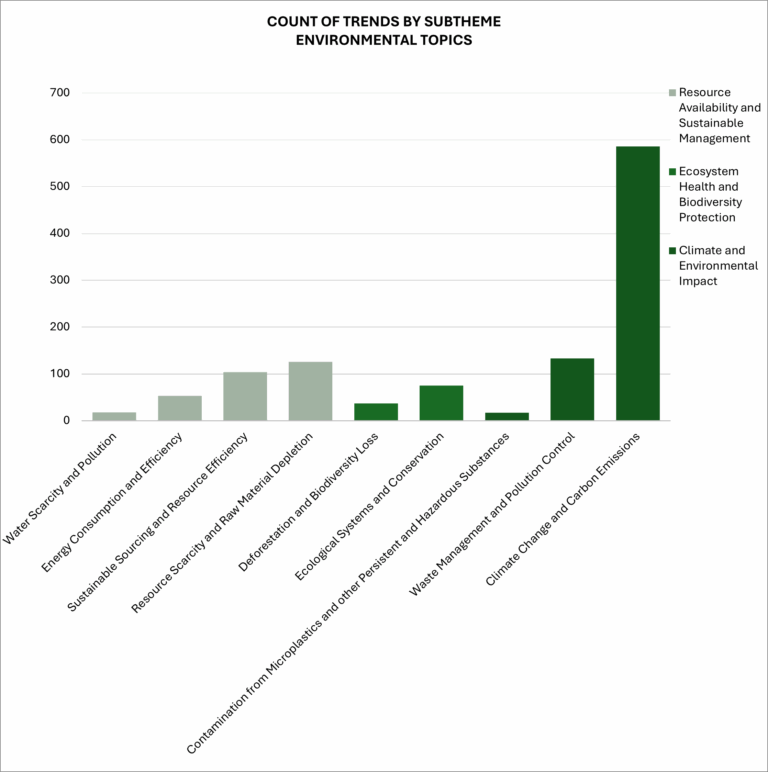
Economic Trends
Economic trends are dominated by financial and economic barriers, which include lack of investment, high operational costs, and weak public incentives. Market and business model constraints are also prevalent, reflecting resistance to transitioning from linear to circular models. Resource and material security trends, though fewer, point to supply chain vulnerabilities and price instability.
The mapping of signals underscores that financial feasibility and market readiness are perceived as the most immediate and critical challenges to implementing circular practices in the wood cascading sector.
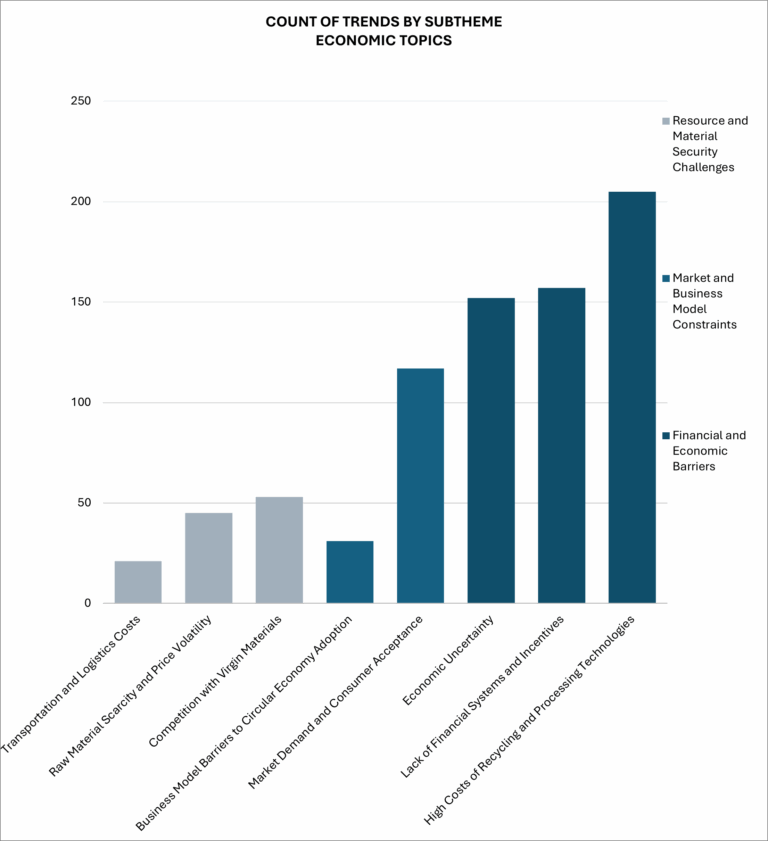
Political Trends
Political trends are associated with policy and regulatory coherence, indicating persistent concerns over fragmented legislation and weak enforcement. Governance issues, including corruption and political instability, also feature prominently and are seen as barriers to long-term circular planning.
Geopolitical risks, while fewer, highlight global trade tensions and strategic resource dependencies. The mapping of trends identified by experts suggests that enabling circular transitions will require not just policy frameworks, but also political stability, integrity, and coordination – particularly in aligning regulations and mitigating global vulnerabilities.
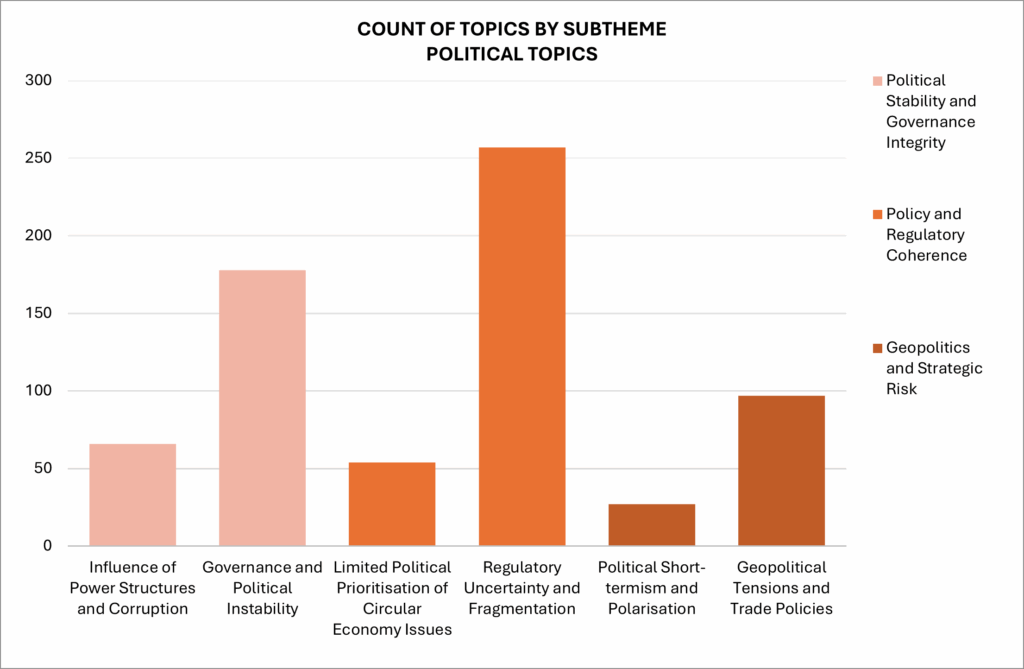
Values-related trends
Values-related trends highlight shifts in societal norms toward sustainability, underlining growing ethical expectations, intergenerational responsibility, and corporate accountability. Tensions between economic growth and environmental ethics are also prevalent, revealing conflicts between profit logics and circular goals. Trust and transparency challenges – including greenwashing and misinformation – round out the landscape.
The mapping reflects a cultural shift in which public perception, moral imperatives, and generational values are increasingly central to enabling or hindering the adoption of circular practices.
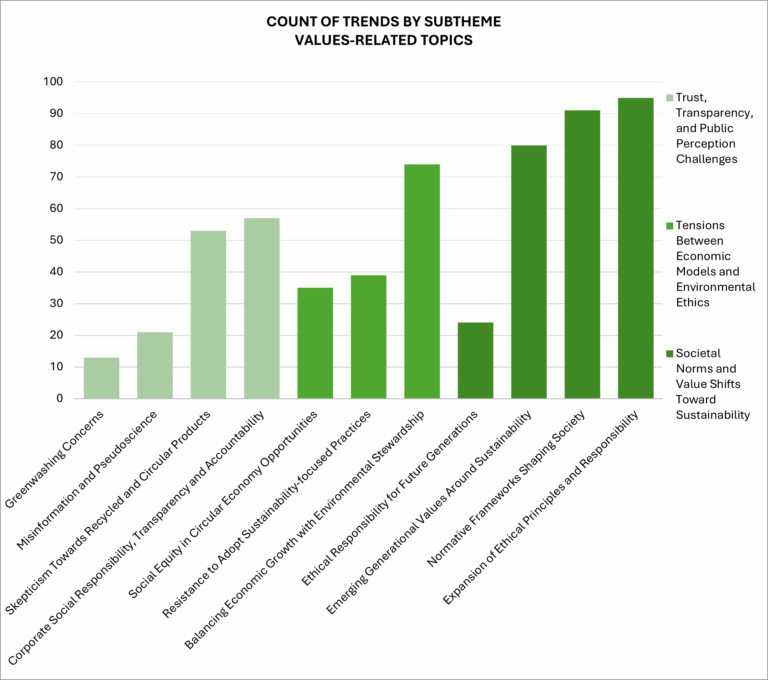
Technological Trends
The majority of technological trends address recycling and circular infrastructure gaps, especially for wood sorting and recovery. Digitalisation and intelligent systems are also prominent, pointing to rising interest in AI and real-time tracking.
Trends in material and energy innovation are fewer but signal future-oriented potential, including bio-based alternatives and low-energy processes.
The mapping of trends shows that foundational tech challenges remain a bottleneck, with digital solutions and sustainable material innovations offering pathways forward – though still limited in scale and deployment.

Social trends
Social trends concentrate around workforce transformation, sustainability awareness, and changing consumption behaviours. The highest number of trends relate to social awareness, reflecting growing but uneven understanding of circular economy principles. Workforce transformation trends are also significant, pointing to critical skills gaps and demographic challenges.
Consumption behaviour trends are fewer but highlight an emerging shift toward sustainable preferences. Overall, the mapping of trends reveals that social enablers – especially knowledge, training, and values – are central to circular economy transitions, though practical engagement and structural change remain limited.
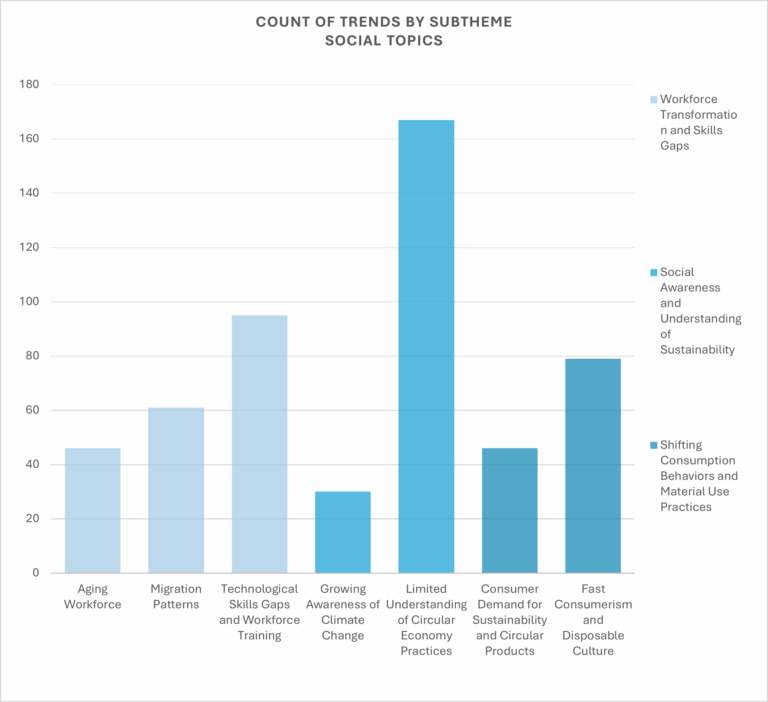
Methodological synthesis
The horizon scanning survey engaged 380 multidisciplinary experts to identify emerging, established, and weakening trends in circular wood use. A purposive sampling strategy was employed to ensure contextual expertise rather than statistical representativeness. Participants were selected for their knowledge in areas such as labour markets, industrial technologies, environmental governance, sustainable design, and sociotechnical transitions. Additional outreach targeted specialists in adaptive sorting systems, bioremediation, energy valorisation, lignin extraction, and digital product passports.
The survey was distributed via Horizon Europe networks, RTO and academic channels, and professional associations. Hosted on the Webropol platform, data collection occurred between March and April 2025. The survey attracted international participation. The majority of responses came from Finland (9%), Italy (7%), Portugal (6%), Spain (6%), Canada (5%). Several other countries including United States, India, Germany and Greece featured ≥3% of participants. Sectoral representation was led by academia (51%) and RTOs (27%), with additional input from industry (8%), consulting (5%), public sector (3%), and civil society (3%). Educational attainment was high: 66% held doctoral degrees, and 26% held master’s degrees. The gender split was 67% male, 30% female, and 3% undisclosed. The age distribution reflected a mature expert base: 76% were aged 35–64, ensuring a depth of experience and foresight capacity to inform scenario development and policy design.
The trends identified by experts were analysed using a two-stage hybrid methodology that combined qualitative thematic coding by domain experts with SBERT-based machine learning. Experts first identified key themes and subthemes, after which SBERT embeddings and cosine similarity clustering were used to group semantically related trends and reduce redundancy. This approach balanced expert insight with computational scalability, resulting in 4,291 thematically classified trends refined through expert review.
